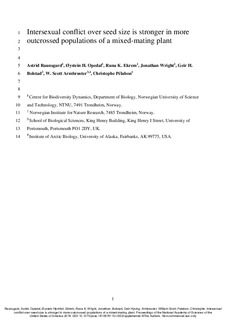| dc.contributor.author | Raunsgard, Astrid | |
| dc.contributor.author | Opedal, Øystein Hjorthol | |
| dc.contributor.author | Ekrem, Runa K | |
| dc.contributor.author | Wright, Jonathan | |
| dc.contributor.author | Bolstad, Geir Hysing | |
| dc.contributor.author | Armbruster, William Scott | |
| dc.contributor.author | Pelabon, Christophe | |
| dc.date.accessioned | 2019-02-11T10:14:20Z | |
| dc.date.available | 2019-02-11T10:14:20Z | |
| dc.date.created | 2018-10-22T10:20:19Z | |
| dc.date.issued | 2018 | |
| dc.identifier.issn | 0027-8424 | |
| dc.identifier.uri | http://hdl.handle.net/11250/2584741 | |
| dc.description.abstract | In polyandrous species, fathers benefit from attracting greater maternal investment toward their offspring at the expense of the offspring of other males, while mothers should usually allocate resources equally among offspring. This conflict can lead to an evolutionary arms race between the sexes, manifested through antagonistic genes whose expression in offspring depends upon the parent of origin. The arms race may involve an increase in the strength of maternally versus paternally derived alleles engaged in a “tug of war” over maternal provisioning or repeated “recognition-avoidance” coevolution where growth-enhancing paternally derived alleles evolve to escape recognition by maternal genes targeted to suppress their effect. Here, we develop predictions to distinguish between these two mechanisms when considering crosses among populations that have reached different equilibria in this intersexual arms race. We test these predictions using crosses within and among populations of Dalechampia scandens (Euphorbiaceae) that presumably have experienced different intensities of intersexual conflict, as inferred from their historical differences in mating system. In crosses where the paternal population was more outcrossed than the maternal population, hybrid seeds were larger than those normally produced in the maternal population, whereas when the maternal population was more outcrossed, hybrid seeds were smaller than normal. These results confirm the importance of mating systems in determining the intensity of intersexual conflict over maternal investment and provide strong support for a tug-of-war mechanism operating in this conflict. They also yield clear predictions for the fitness consequences of gene flow among populations with different mating histories. | nb_NO |
| dc.language.iso | eng | nb_NO |
| dc.publisher | National Academy of Sciences | nb_NO |
| dc.title | Intersexual conflict over seed size is stronger in more outcrossed populations of a mixed-mating plant | nb_NO |
| dc.title.alternative | Intersexual conflict over seed size is stronger in more outcrossed populations of a mixed-mating plant | nb_NO |
| dc.type | Journal article | nb_NO |
| dc.type | Peer reviewed | nb_NO |
| dc.description.version | acceptedVersion | nb_NO |
| dc.source.journal | Proceedings of the National Academy of Sciences of the United States of America | nb_NO |
| dc.identifier.doi | 10.1073/pnas.1810979115 | |
| dc.identifier.cristin | 1622132 | |
| dc.relation.project | Norges forskningsråd: 223257 | nb_NO |
| dc.description.localcode | © 2018. This is the authors' accepted and refereed manuscript to the article. The final authenticated version is available online at: https://doi.org/10.1073/pnas.1810979115 | nb_NO |
| cristin.unitcode | 194,66,10,0 | |
| cristin.unitname | Institutt for biologi | |
| cristin.ispublished | true | |
| cristin.fulltext | postprint | |
| cristin.qualitycode | 2 | |
